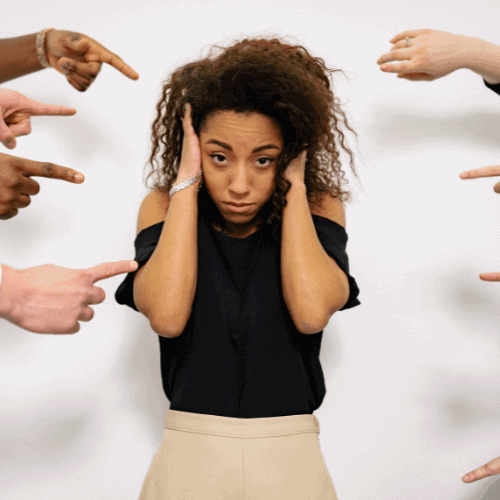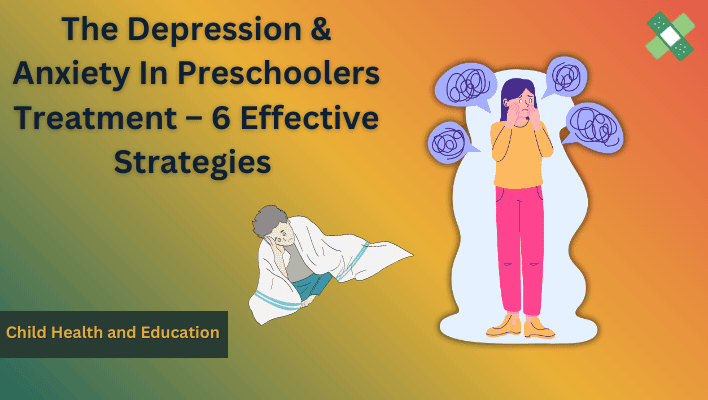As a parent, seeing your preschooler struggle with anxiety can be frustrating and worrying. Anxiety in preschoolers is common, and several treatment options are available. In this blog, we’ll explore the six strategies for anxiety in preschoolers treatment and discuss anxiety in children under 10 years old.
From therapy to medication, many options exist for helping your child manage their anxiety and enjoy a more peaceful childhood. So, let’s dive in and learn about anxiety in preschoolers treatment and when to worry about child anxiety. The last child anxiety test also performs for young children with anxiety symptoms.
What is Anxiety?
Anxiety is a natural emotion that everyone experiences at some point in their lives. It is the body’s reaction to stress or danger. Anxiety becomes a problem when it begins to interfere with daily life. Preschoolers may experience anxiety about being away from their parents, starting school, meeting new people, or other things.
Now discuss the symptoms and then move towards anxiety in preschoolers treatment strategies.

Symptoms of Anxiety in Preschoolers
It can be difficult to recognize anxiety in preschoolers since they may not have the language skills to express their feelings. Symptoms of anxiety in preschooler’s treatment may include:
- Excessive crying or whining
- Temper tantrums
- Refusal to go to school or take part in social activities
- Difficulty sleeping or staying asleep
- Clinging behavior
- Stomachaches or headaches without an underlying medical condition
Now move towards our main topic about anxiety in preschoolers treatment and child anxiety tests at home.
Anxiety in Preschoolers Treatment – 6 Effective Strategies
The good news is that there are several effective strategies for anxiety in preschoolers treatment. We’ll explore six of them.
1. Cognitive Behavioral Therapy (CBT)
Cognitive Behavioral Therapy is a type of talk therapy that helps children understand and change how they think about their fears. During CBT sessions, a therapist will work with your child to identify what’s causing their anxiety and teach them coping skills to manage their emotions better.
2. Play Therapy
Play therapy involves using toys or other materials to help your child express their feelings and work through their worries. A play therapist may use puppets, dolls, art supplies, or other tools to help your child feel comfortable discussing their anxiety.
3. Medication
The use of medication for anxiety in children under 10 and 7 years old should always be guided by a pediatrician or psychiatrist. While drugs can be helpful for some children with severe symptoms, they’re often not necessary for preschool-aged kids.
4. Mindfulness Meditation
Mindfulness meditation teaches children to pay attention to the present moment without judgment or distraction. This practice can help reduce anxiety by improving focus and concentration while promoting relaxation.
5. Parent Training
Anxiety can affect the whole family unit just as much as it affects the individual experiencing it directly. Teach parents things like how to respond when their child is anxious so they are validating them rather than reinforcing the anxiety behavior; like praising trying hard/staying calm during times when previously anxious behaviors might have reared up–not necessarily celebrating progress but “process praise.”
Parent training also aims at helping parents identify situations that trigger the preschooler’s anxiety so modifications can be made for their betterment.
6. Lifestyle Changes
Building a healthy and balanced lifestyle is important, even for preschoolers. Adequate sleep, a nutritious diet, and regular exercise can significantly lower anxiety levels. Encourage socializing with other kids too!
The above points are the anxiety in preschoolers treatment and treatment that experts use. These treatments and methods are beneficial for both the parent and the child.
How to Treat Anxiety in Child Naturally?
Anxiety is a common condition that can affect children of all ages. Many parents might look for natural remedies to help their children cope with symptoms rather than relying solely on medication. Here are some ways for anxiety in preschoolers treatment naturally:
1. Deep Breathing
Teaching your child breathing exercises can be an effective way to alleviate anxiety. Encourage your child to take deep breaths and exhale slowly when feeling anxious.
2. Exercise
Regular physical activity has been shown to help reduce stress and anxiety in children. Encourage your child to engage in activities such as running, swimming, or playing sports.
3. Mindfulness
Practicing mindfulness techniques, such as meditation or yoga, can help children learn how to manage their emotions and stay calm during stressful situations.
4. Aromatherapy
Essential oils like lavender or chamomile have calming properties that can benefit children with anxiety. Place a few drops into a diffuser or use a roller bottle for easy application.
5. Diet Changes
Encouraging healthy eating habits is essential for overall physical and mental health. Foods rich in magnesium, like almonds, spinach and avocados, are amazing food options linked to reducing anxiety levels.
It’s important to note that while natural remedies might help alleviate symptoms of anxiety in some cases, they should not completely replace professional treatment recommended by mental health professionals if necessary.
Suppose your child is exhibiting signs of severe anxiety or depression. In that case, it’s essential to seek professional help from mental health experts who can provide the best possible support and treatment options based on their needs.
When to Worry About Child Anxiety
Anxiety is a common emotion that all children experience from time to time. It is a vital component of growth and development, but in some cases, children’s anxiety may become excessive and interfere with their daily activities.
Now we will discuss when parents should worry about their child’s anxiety levels.
1. When Anxiety Causes Significant Distress
Anxiety disorders can lead to significant emotional distress in children. Suppose your child appears excessively worried or fearful for long periods without an apparent reason, and the symptoms persist for weeks or months. In that case, it might indicate an anxiety disorder. These symptoms can manifest physically and emotionally, such as experiencing frequent panic attacks or refusing to attend school.
2. When Anxiety Interferes with Daily Activities
Pay attention when your child’s anxiety starts interfering with routine activities like socializing at school, attending events with friends, or even playing sports. Avoiding these activities because of persistent anxious feelings might harm their social and emotional well-being. For instance, if your child avoids school because of separation anxiety, it might result in serious academic problems.
3. When Anxiety Distracts Them from Learning
Suppose excessive fear distracts a student during class activities and causes them trouble concentrating or memory retention on tasks that require attention, like homework and studying. In that case, it might reflect on their exam scores.
Child Anxiety Test at Home: A Complete Guide
If you suspect that your child is struggling with anxiety but are unable to schedule a visit to a mental health specialist, there are several tests you can administer at home. These tests can indicate the level of anxiety and whether or not professional help may be necessary. Here’s what you need to know:”
1. Why Testing for Child Anxiety Can Be Helpful
- Understanding the types of anxiety disorders and their symptoms
- Identifying potential triggers and causes
- Normalizing feelings and reassuring your child
2. Types of Anxiety Tests for Children
- Self-reporting questionnaires: Your child answers questions about themselves and their anxiety levels.
- Structured Diagnostic Interviews: Look at anxiety symptoms & ask the child/adolescent follow-up questions to determine a diagnosis.
- Behavioral Observations: Observe how your child behaves in high-anxiety situations.
3. How to Administer the Tests
- Create a relaxing environment that fosters open communication
- Choose questions that suit your child’s age range
- Consider using pictures or other visual aids to help young children understand the questions better
4. Interpreting The Results
It’s critical to note that these tests are only meant to indicate possible anxiety levels; they shouldn’t be used as a basis for diagnosing anxiety disorders on their own. A trained mental health professional should always validate any interpretations.
5. Next Steps After Test Results Are Revealed
If the test results indicate significant overall anxiety issues, it’s time to contact a mental health professional immediately who can validly diagnose and provide appropriate treatment options.
Read more about health and hygiene in childcare.
Conclusion
Anxiety in preschoolers treatment through various approaches like Cognitive Behavioral Therapy (CBT), Play Therapy, Mindfulness Meditation and more mentioned above in this blog.
As parents of anxious preschoolers, you want them to have access to all the tools they need to manage their worries now and in the future. Whether you choose therapy, medication or other treatment options, it’s crucial that your child feels loved and supported through their journey. So, stay positive!
How can I help my preschooler with anxiety?
There are several ways parents can help their preschoolers with anxiety:
Provide emotional support and reassurance.
Create a predictable routine with regular meal times, bed, and play times.
Encourage physical exercise, outdoor play, and relaxation activities such as deep breathing or mindfulness.
Teach your child simple coping strategies such as counting or naming emotions.
What is the most effective method for anxiety?
There is no single solution that works for everyone. However, evidence-based treatment for children’s anxiety includes cognitive-behavioral therapy (CBT), medication, or a combination of both. CBT focuses on helping children change their thoughts and behaviors related to anxiety through various techniques such as exposure therapy or relaxation training. A healthcare provider may recommend medication if severe symptoms interfere with daily functioning.
What is the first-line treatment for anxiety in children?
The American Academy of Child and Adolescent Psychiatry recommends psychological treatments such as CBT as the first-line treatment for mild to moderate anxiety in children. Medication may be considered in consultation with a child psychiatrist for severe cases or those not responding to therapy. It’s important to note that treatment should be individualized based on the child’s needs and preferences.
What methods treat anxiety in children?
Several methods treat anxiety in children depending on the severity of the condition. These include cognitive behavioral therapy, psychotherapy, medication (such as antidepressants), and relaxation techniques.
What exercises are best for anxiety?
Physical exercise is an effective way to manage anxiety. Exercises such as yoga, deep breathing, progressive muscle relaxation, and mindfulness meditation have also been shown to be helpful.
What causes anxiety in the brain?
A combination of genetics, brain chemistry, personality traits, life experiences and stressors causes anxiety. The amygdala, which is responsible for our “fight or flight” response, triggers anxiety symptoms.

